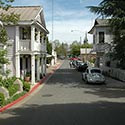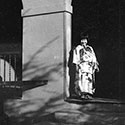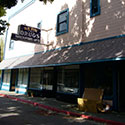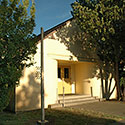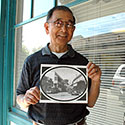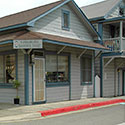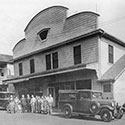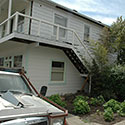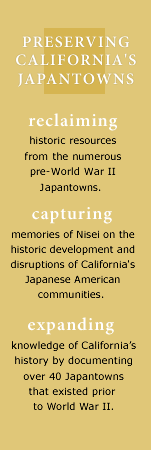 |
Walnut GroveEarly Japanese immigrants described travel through the Sacramento Delta area as going "down river," leading the Issei to call the area around Walnut Grove, "Kawashimo." Chinese immigrants had harnessed the delta’s fertility in the 1870-80s by creating a network of levees and inland islands that controlled flooding in what had been a marshy swamp. White landowners reaped the primary benefits from this major project of land "reclamation" and dominated the local economy, along with the multiethnic population of immigrants who arrived in succession from China, Japan, East India, the Philippines and Mexico to work the fields around Walnut Grove. Unlike other Japanese agricultural settlements, where some immigrants were able to purchase land and establish independent farms, Kawashimo remained wholly owned by a few white landholders. Issei farmers arrived in Walnut Grove after 1892 and established themselves in fruit, tomatoes, beans and asparagus production, first as itinerant contract laborers and then through tenant farming. Walnut Grove emerged as a hub for Japanese in the delta area and by the 1930s, over 100 Nikkei families farmed around Walnut Grove. Kawashimo’s Japantown had a bustling commercial area to serve their recreational and material needs, as well as community institutions such as the Buddhist and Methodist Churches, a Japanese language school, Kenjinkai (prefectural associations) and Japanese Association. ›› CLICK TO ENLARGE.
PROFILES
| ||||

In 1915, a catastrophic fire consumed Walnut Grove's Chinatown and a portion of the smaller Japantown. Tensions between these communities led the Japanese immigrants to rebuild on adjacent blocks owned by Alex Brown, a farmer, banker and major landholder who helped amend the Alien Land Laws to maintain his profitable relationship with Japanese immigrants. Brown installed water and sewage lines and constructed seven commercial buildings offered for rent, along with additional parcels on which he encouraged Nikkei to build. Families drew numbers out of a hat to determine on which lot they would build their homes and businesses. Japanese builders and carpenters came from as far as San Francisco to lend their expertise and labor to the task of rebuilding Kawashimo's Japantown. The neighborhood still features the narrow streets lined by two-story wooden structures with overhanging balconies that the Issei created in 1915. Even the underlying property arrangements, in which Nikkei owned the house but not the underlying land, were not changed until the late 1990s.
As a rare example of a Japanese enclave designed and built by immigrants themselves, the commercial core of Walnut Grove's Japantown was designated a National Register historic district in 1990 (as was the neighboring Chinatown). The Preserving California's Japantowns volunteer survey team of Barbara Takei, Janet Sakata and Louie Watanabe made an important contribution to the existing National Register information by documenting the "backtown" area of Walnut Grove's Japantown. Just to the east across the Southern Pacific railroad tracks, "backtown's" larger blocks held many Nikkei residences, as well as a hotel, auto garages and the Buddhist Church and Japanese School building.

Japanese language schools, or gakuen, were critical components of almost all Japantowns. Most taught an assimilationist ethic designed to create "good American citizens," along with the basics of reading and writing in Japanese. Because Walnut Grove's Japanese community was in a particularly tenuous position as tenants of one landowner, assurance that families could return to Japan if necessary made Walnut Grove's Gakuen even more important. By 1920, nearly 400 Nisei children lived in the Walnut Grove area and a Japanese language school had been in operation on Winnie Lane for seven years. When the 1921 law enabling segregated schools was passed, Walnut Grove's Issei began raising funds for a dedicated school to ensure that their children received education in Japanese language and culture. In 1927, the community erected a new building on nearly an acre of land in the "backtown" neighborhood. The building façade features an arcade with arched openings evident in this 1928 image of Sakaye Sato. The covered walkway just behind her once held an inscription running the length of the building listing the names of all of the original donors. The property around the Walnut Grove Gakuen Hall finally came into the hands of the Nikkei community in 1970 when a group of residents formed a cooperative and purchased the land. Photo courtesy of Barbara Takei.

Alex Brown developed this large commercial building with residences above on Market Street as part of the post-1915 fire Japantown. The building initially held four residences and fourteen businesses including two fish markets, a dry goods store, two groceries, a shoe store, a tailor, a noodle shop. Murakami Taxi, also housed in this building, offered a critical service for local Nikkei who owned few cars and did not have access to public transportation. In later decades, Hirotsu tailors and Ben's Drug Store, operated by Ben Kato, occupied ground floor space in the building. The original structure extended more than 100 feet to the south until that portion was torn down after WWII.

By the early 1920s, Walnut Grove's commercial sector had mushroomed to include two hotels, two boarding houses, five grocery stores, eight restaurants and soda fountains, three barbershops, two drugstores, three dry good stores, a tofu-ya, and a soda bottling company. In the 1930s, Kawashimo held fifteen boarding houses and the Hayashi family owned one of seven Nikkei grocery stores. They had moved their grocery store after the 1915 fire from a building located a few blocks south to this large structure, which still stands at the corner of B Street and Tyler. In addition to sales at their storefront, grocery businesses like Hayashi made a good portion of their income through delivering provisions to labor camps in the outlying area. Photo collection of Ralph Sugimoto.

Walnut Grove was one of four Sacramento County school districts to utilize a 1921 law enabling the establishment of segregated schools. "Oriental Schools" in the rural communities of Florin, Courtland, Isleton and Walnut Grove reflected pervasive systems of racial discrimination and the perceived threat that Nikkei farmers' success posed to white residents. Walnut Grove's first segregated school was a six-room structure two blocks south of Japantown, between the asparagus packing plant and Chinatown. Funding from the federal Works Progress Administration allowed for the construction of this larger public elementary school just to the east across the railroad tracks from the first school. Prior to WWII, all of the children of Walnut Grove's Japanese, Chinese and Filipino families attended this school, which features a decorative silhouette of a Chinese junk on pole near the main entry.

Barbershops, boarding houses and pool halls that catered to the needs of a primarily single-male population were important components of early Japantowns. Because hundreds of seasonal workers flooded Kawashimo during planting and harvesting seasons, these commercial establishments remained vital in Walnut Grove. One barber remembered cutting hair from dawn to dusk on weekend days before WWII, when Walnut Grove was flooded with laborers in town for haircuts, baths, food and entertainment. The Kawamura family established a barbershop in Walnut Grove’s Chinatown in 1913, and moved to this location at the corner of Main and B Streets in 1916. Mr. Wakimoto from Sacramento is reported to have donated his time and some materials to assist the Kawamuras in erecting this structure, which housed a variety of small businesses in its northern storefront over the years including a fruit stand, soda pop shop and a wine bar. Nisei Naoko Kawamura owns the business and as of 2008, still gives the occasional haircut.

Built around 1916, this structure was operated in the 1920s and '30s by the Miyazaki family as a boarding house and sento, one of two public bathhouses in Walnut Grove. Small rooms on either side of a narrow second-floor hallway served Nikkei lodgers and migrant workers who labored seasonally in the fields of Kawashimo. A trip to town in the off season or on Saturday night might include a game of cards or pool, and a long, relaxing soak at the Miyazaki or Adachi bathhouse. The one-story bathhouse at the rear of the Miyazaki building -- its two bathing areas (for men and women) still vibrant with the green, pink and black tiles of pre-WWII days -- is being restored by the property's current owner. The trees to the right of the building have grown up at the former site of Mary's Restaurant and Watanabe boarding house.

Born and raised in Walnut Grove, Louie Watanabe holds a historic photograph of Market Street (then First Street) that shows the restaurant and boarding house run by his parents before WWII. One of two Japantown establishments that served Western-style food, Mary's Restaurant served meals for 25 cents to Kawashimo residents, seasonal Japanese farm laborers, and the white truck drivers who rented rooms upstairs. Watanabe remembers learning to play cards from the truckers who stayed at the boarding house and the bathhouse and candy store next door where he would get shaved ice from the Miyazaki family. He recalled the special "closeness among Nihonjin (Japanese people) in Walnut Grove - everyone was like family." The Watanabe's restaurant and boarding house was one of several Nihonmachi structures that burned to the ground during WWII, including the Japanese Association Hall and Theater.
